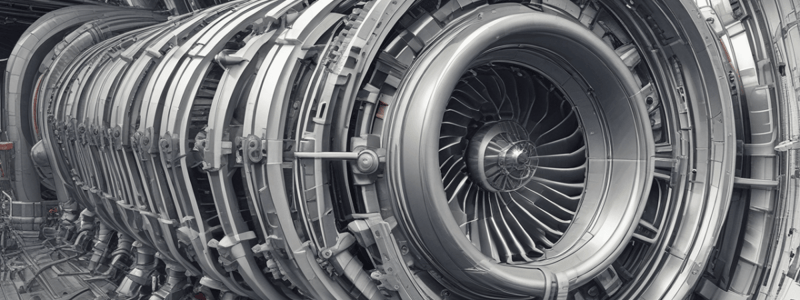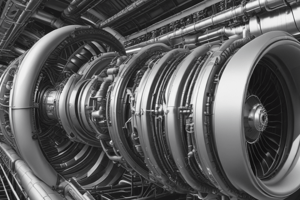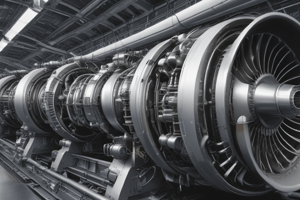Podcast
Questions and Answers
What is the benefit of engine-mounted inlet ducts?
What is the benefit of engine-mounted inlet ducts?
- Increased internal skin friction
- Improved engine performance at supersonic speeds
- Reduced engine noise
- Short, efficient inlet ducts with minimal internal skin friction (correct)
What materials are inlets constructed from?
What materials are inlets constructed from?
- Steel and chrome
- Aluminium alloy and/or composites such as carbon fibre and Kevlar (correct)
- Copper and bronze
- Stainless steel and titanium alloy
Where are the inlet ducts mounted on some multi-engine jet aircraft?
Where are the inlet ducts mounted on some multi-engine jet aircraft?
- On the wings
- On the nose cone
- Directly onto the front of the engine or part of the fuselage, engine pylon, or stub wing structure (correct)
- On the tail section
What is the ideal air inlet for a turbojet engine at subsonic or low supersonic speeds?
What is the ideal air inlet for a turbojet engine at subsonic or low supersonic speeds?
Why does the efficiency of the single-entry pitot type inlet begin to fall at sonic speed?
Why does the efficiency of the single-entry pitot type inlet begin to fall at sonic speed?
Where are the inlet ducts mounted on single-engine and some twin-engine military aircraft?
Where are the inlet ducts mounted on single-engine and some twin-engine military aircraft?
What is the purpose of allowing air to diffuse in the front portion of the duct?
What is the purpose of allowing air to diffuse in the front portion of the duct?
What happens to inlet pressure as the aircraft reaches its desired cruising speed?
What happens to inlet pressure as the aircraft reaches its desired cruising speed?
What is the result when the flight inlet, compressor, combustor, turbine, and tailpipe are not in match with each other?
What is the result when the flight inlet, compressor, combustor, turbine, and tailpipe are not in match with each other?
What is the primary difference between a turbofan inlet and a turbojet inlet?
What is the primary difference between a turbofan inlet and a turbojet inlet?
What occurs when the aircraft begins to move forwards on the ground?
What occurs when the aircraft begins to move forwards on the ground?
At what speed range does ram recovery normally begin to occur in most aircraft?
At what speed range does ram recovery normally begin to occur in most aircraft?
What is the primary function of the spill valve in a moveable spike inlet?
What is the primary function of the spill valve in a moveable spike inlet?
At twice the speed of sound, what pressure ratio is possible in a moveable spike inlet?
At twice the speed of sound, what pressure ratio is possible in a moveable spike inlet?
What is the purpose of the wedge in a moveable spike inlet during supersonic flight?
What is the purpose of the wedge in a moveable spike inlet during supersonic flight?
What happens to the compression provided by the engine as aircraft speed increases?
What happens to the compression provided by the engine as aircraft speed increases?
What is the purpose of the divergent area in a moveable spike inlet?
What is the purpose of the divergent area in a moveable spike inlet?
What is the function of the dump valve in a moveable spike inlet during subsonic flight?
What is the function of the dump valve in a moveable spike inlet during subsonic flight?
What can happen if the anti-ice system is used to de-ice the inlet area after compressor stalls occur from ice formation?
What can happen if the anti-ice system is used to de-ice the inlet area after compressor stalls occur from ice formation?
When is anti-icing heat typically required?
When is anti-icing heat typically required?
What type of anti-icing system is used in some smaller turboprop and turboshaft engines?
What type of anti-icing system is used in some smaller turboprop and turboshaft engines?
Why do electro-thermal anti-icing systems need to be cycled on and off?
Why do electro-thermal anti-icing systems need to be cycled on and off?
What is used to anti-ice the engine and inlet in one type of system?
What is used to anti-ice the engine and inlet in one type of system?
When should electro-thermal anti-icing systems be operated?
When should electro-thermal anti-icing systems be operated?
What is the purpose of the movable spike in a moveable wedge inlet?
What is the purpose of the movable spike in a moveable wedge inlet?
What type of shock waves develop at the lip of the inlet as airspeed increases to supersonic?
What type of shock waves develop at the lip of the inlet as airspeed increases to supersonic?
What is the primary function of a bellmouth inlet?
What is the primary function of a bellmouth inlet?
What shape is the bellmouth inlet convergent to?
What shape is the bellmouth inlet convergent to?
What is the typical location of bellmouth inlets?
What is the typical location of bellmouth inlets?
What happens to the 'mouse' as airspeed increases to supersonic?
What happens to the 'mouse' as airspeed increases to supersonic?
Study Notes
Inlet Construction
- Inlet ducts can be mounted directly onto the front of the engine or form part of the fuselage, engine pylon, or stub wing structure.
- Inlets are constructed from aluminium alloy and/or composites such as carbon fibre and Kevlar.
- Inlets forming part of the aft fuselage may have a long “S” shaped duct.
Inlet Configurations
- Single-Entry (Pitot) Type Duct: ideal for subsonic or low supersonic speeds, makes full use of ram effect, and suffers minimum loss of ram pressure with changes in aircraft attitude.
- Single-Entry Type Duct: as sonic speed is approached, its efficiency begins to fall due to the formation of a shock wave at the inlet lip.
Effects of Inlet Configurations
- Inlet pressure increases significantly add to the mass airflow as the aircraft reaches its desired cruising speed.
- The compressor reaches its aerodynamic design point and produces its optimum compression and fuel economy at cruising speed.
- If any section of the engine does not match the others for whatever reason, engine performance will be affected.
Turbofan Inlet
- Similar in design to the turbojet inlet, but discharges only a portion of its air into the gas generator, with the remainder passing into the fan.
Ram Pressure Recovery
- When the aircraft engine is operated on the ground, there is a negative pressure in the inlet due to the high velocity of the mass airflow being drawn into the inlet by the compressor.
- As the aircraft begins to move forwards, air is rammed into the inlet and ram recovery takes place, cancelling the drop in pressure in the inlet.
- Ram recovery normally begins to occur at speeds between Mach 0.1 and Mach 0.2 in most aircraft.
Moveable Spike Inlet
- Provides a similar function of convergence, divergence, and shock wave formation.
- Has a spill valve to dump unwanted ram air overboard at high speed.
- Allows for full advantage of energy recovery at high speeds.
Bellmouth Inlets
- Convergent in shape, commonly found on helicopters and engine test cells.
- Present a mouth considerably wider in circumference than the engine compressor inlet and smoothly converge, funnelling air down to compressor inlet circumference.
- Eliminate the ‘necking down’ effect of an airstream passing through a plain orifice, and allow the engine to draw all the air it can use.
Inlet Anti-ice
- Anti-ice systems are used to prevent ice formation on the inlet.
- Turbofan: uses hot air from the compressor to anti-ice the inlet.
- Turboprop: uses electric heat strip systems or hot engine or reduction gearbox oil to anti-ice the engine and inlet.
Studying That Suits You
Use AI to generate personalized quizzes and flashcards to suit your learning preferences.
Related Documents
Description
This quiz covers the construction of inlet ducts in gas turbine engines, including engine-mounted inlet and inlet construction on fuselage.




